The Best Three Learning Spanish & English Titles in One eBook Collection Simply Spanish for English Speakers Speak Spanish Flashcards for English Speakers Simply English for Spanish Speakers
By: Ally Hudson;
Edited by Deaver Brown Quick, consise, helped me learn Spanish. Showed words on my Kindle or iPad when traveling to be clearer. Worked well. Inexpensive too. Janet Foster, Boston. 2014 Bought as a starter version to learn Spanish for work; all I needed.
Less than most Starbucks drinks, which I also like! Tom Nelson, Dallas. 2015 Simply English helped me get a better job in customer service. Great price too. Later helped me pass Immigration Test, with their Immigration audiobook & eBook. Cheap enough I could buy both. 2016 Spanish flashcards helped me pass Spanish in school; my friends got them too. 2016 Spanish flashcards helped me pass Spanish in school; my friends got them too.
Real cheap. Nice. Billy Smith. Chicago. 2016 Simply Media Inc. POB 481 Lincoln, MA 01773-0481 simplymedia is a trademark of Simply Media Inc.
Copyright 2016 by Deaver Brown Write: with questions, corrections, or anything else on your mind. Your comments will make us better and help everyone from then on!  Simply Spanish for English Speakers Part IChapter 1: An Introduction to Spanish for Practical Use The objective of this title is to make learning Spanish both fun and easy. Learning Spanish opens a gateway to greater success in American organizations and business life, as well as in school, in community, with friends, and during travel to Spanish speaking countries. Do not press yourself to learn too much too quickly. The best way to learn is to begin with the Spanish alphabet and basic numbers, both of which are more similar to English than French or Italian. Then work with a core group of words and phrases that you can use in everyday life with customers, clients, vendors, suppliers, service providers, and friends.
Simply Spanish for English Speakers Part IChapter 1: An Introduction to Spanish for Practical Use The objective of this title is to make learning Spanish both fun and easy. Learning Spanish opens a gateway to greater success in American organizations and business life, as well as in school, in community, with friends, and during travel to Spanish speaking countries. Do not press yourself to learn too much too quickly. The best way to learn is to begin with the Spanish alphabet and basic numbers, both of which are more similar to English than French or Italian. Then work with a core group of words and phrases that you can use in everyday life with customers, clients, vendors, suppliers, service providers, and friends.
If you work in a service organization, bank, school, or business that caters to Spanish speaking people, make it a point to try out your Spanish with them. Spanish-speakers are always pleased to have others try to communicate with them in their native language. For example, one of our students greets his Spanish-speaking American Banker by saying, Jose, listen to my latest phrase. How did I do? Now thats fun! Another suggestion is to try to communicate with any Spanish workers you are associated with such as a teacher, gardener, or supplier. Use the same kind of approach as we outlined before; ask them to suggest a phrase they would find useful, practice, and the next time you see them, use it. The great part about learning Spanish in the United States is so many people use it; so you can practice on a regular basismaking it fun and easy for everyone! Chapter 2: Helpful Tips while Reading Along Throughout this title, we have alphabetized within our Chapters and sections as much as possible.
We have also put the sections in sequence as much as possible so February appears logically after January. This should help you to find the word that you want. Chapter 3: A Place to Start: the Alphabet and Numbers The Spanish alphabet consists of the same 26 letters as the English alphabet, with 3 slight variations. This makes the two alphabets look very similar. There is none of the complicated punctuation either! Whew! The three different letters in the Spanish alphabet are ch, II, and rr. Think of these as building upon the English alphabet with 3 more letters.
Numbers 1-10 in Spanish are fairly intuitive and easy to learn. As the numbers get higher they are not quite as easy to remember, but dont worry, we will lead you through this process with ease. Additionally, many months and days of the week are similar to their English counterparts. As the world grows smaller, words become International and spread across all languages. As such, new words such as Google, iPOD, passport, radio, and television become understandable in most languages. This is especially true in Spanish and English where the languages frequently overlap.
Core words and phrases are listed throughout Part I and II of the title. They are easy to learn, remember, and put into practice. Now, with these things in mind, lets get started! Think about how this will be a great way to learn a new language to communicate with friends and professional associates. You will also feel comfortable traveling or visiting Spanish countries or neighborhoods in the United States. Have fun! Chapter 4: The Alphabet There are four parts of almost any alphabet: 1) vowels, 2) consonants,3) the English equivalent, and 4) the notation in the pronunciation key. B be Similar to the English letter b but softer; dont close your lips completely (b). C ce Is pronounced as a hard c similar to the English sound ka before a, o, and u, but it is pronounced as a soft c similar to the English sound se before e, and i. CH che One of the four different alphabet letters from English: as in church (ch). D de Softer than the English d, as with the English b. D de Softer than the English d, as with the English b.
Similar to th in then. (d), (th). E e Similar to the a in take but quicker. F efe Similar to the English f (f). G ge Is pronounced as a hard g similar to the g in the English word girl - before a, o, u. H hache Always a silent sound. I i Similar to ee in meet but quicker (ee). J jota Similar to the h in help but quicker (let out more air to make the sound louder) (h). K ka Similar to the English k (k). L ele Similar to the English l (l). LL elle One of the four different alphabet letters from English: it is similar to the y in yet and in some instances like the j in jet (y). M eme Similar to the English m (m) N ene Similar to the English n (n). ee One of the four different alphabet letters from English: a similar sound as in the word union, nyuh (ny). O o Similar to the English o but quicker (o), (oh). P pe Similar to the English p but crisper (p). Q cu Similar to the English k. Q cu Similar to the English k.
Always followed by a u (k). R ere Similar to the English r, a soft rolling rrr sound (r), (rr). RR erre One of the four different alphabet letters from English; a harder rolling r sound (rr). S ese Similar to the English s (s). T te Similar to the English t (t). U u Similar to the oo in coon, loon, or moon.
Crisper (oo). V ve Similar to the English b but softer; pronounced the same as the letter b is in Spanish (see above) (b). W doble ve Similar to English w (w). X equis Similar to the English x just as in ax (ks), (h). Y i griega Similar to the English y as in yes (y). Z zeta Similar to the English s (s).
There are two alphabet combinations worthy of note: -ai and -ay which are pronounced like the English word eye. In summary, you can cut your alphabet learning down to size by noting how many letters are pronounced similarly to their English equivalents. You should focus on these letters; then add-on the more complicated ones. Dont worry about the exceptions; you have enough to be concerned about. The best way to learn is to begin by familiarizing yourself with the alphabet, and then move on to the other basics. Have fun getting this project under your belt before you know it, you will be a Spanish alphabet pro! Chapter 5: Basic Pronunciation There are three simple rules to pronouncing Spanish words correctly.
Repeat and memorize them for simple help with accents. You will notice that this is a much easier approach than in English, French, or many other foreign languages. Rule #1 - When a word ends in a vowel, an n, or an s, stress the
Next page

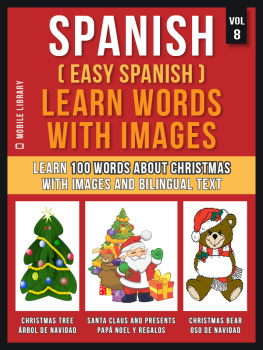

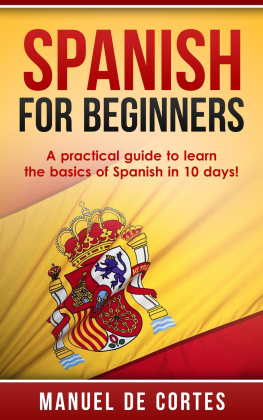
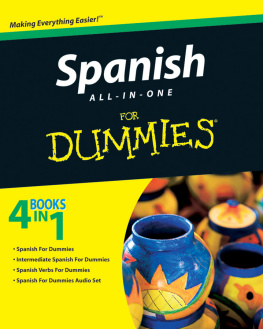
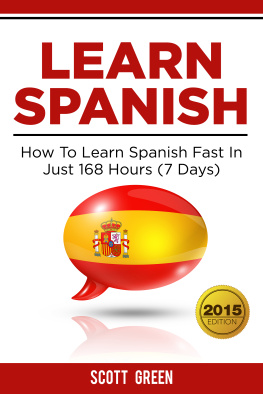
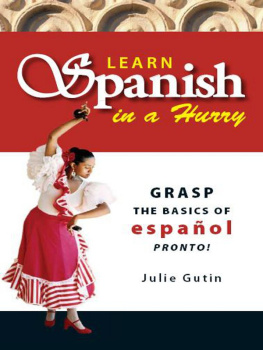
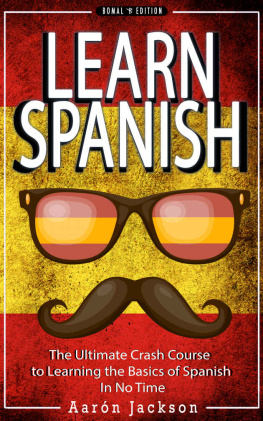
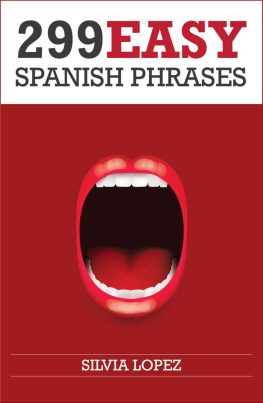

 Simply Spanish for English Speakers Part IChapter 1: An Introduction to Spanish for Practical Use The objective of this title is to make learning Spanish both fun and easy. Learning Spanish opens a gateway to greater success in American organizations and business life, as well as in school, in community, with friends, and during travel to Spanish speaking countries. Do not press yourself to learn too much too quickly. The best way to learn is to begin with the Spanish alphabet and basic numbers, both of which are more similar to English than French or Italian. Then work with a core group of words and phrases that you can use in everyday life with customers, clients, vendors, suppliers, service providers, and friends.
Simply Spanish for English Speakers Part IChapter 1: An Introduction to Spanish for Practical Use The objective of this title is to make learning Spanish both fun and easy. Learning Spanish opens a gateway to greater success in American organizations and business life, as well as in school, in community, with friends, and during travel to Spanish speaking countries. Do not press yourself to learn too much too quickly. The best way to learn is to begin with the Spanish alphabet and basic numbers, both of which are more similar to English than French or Italian. Then work with a core group of words and phrases that you can use in everyday life with customers, clients, vendors, suppliers, service providers, and friends.